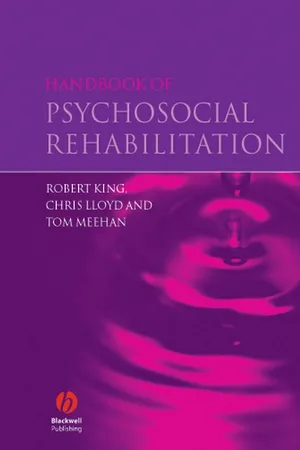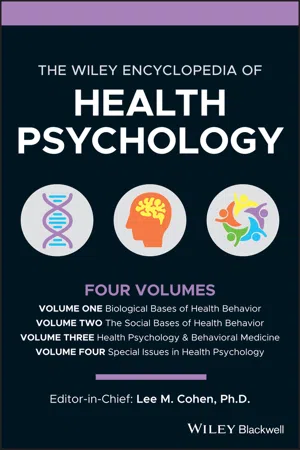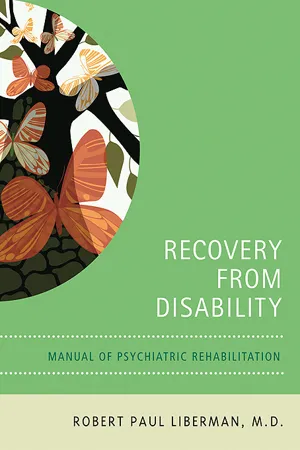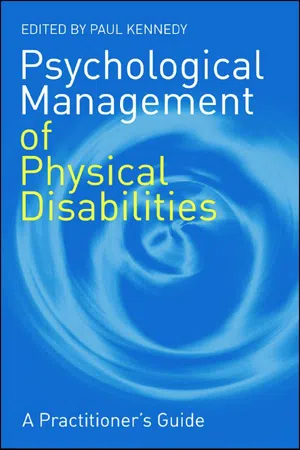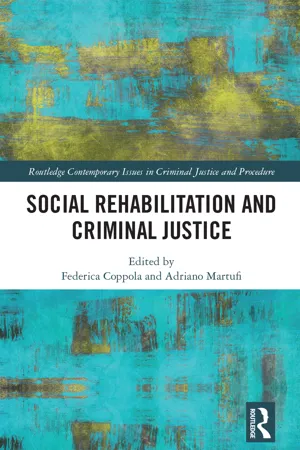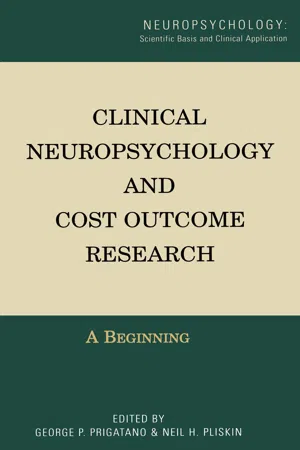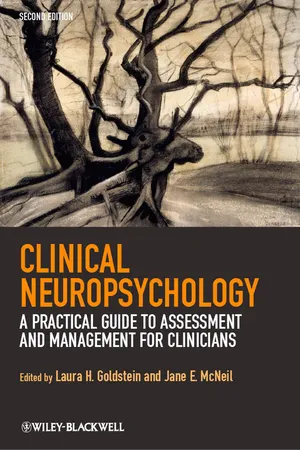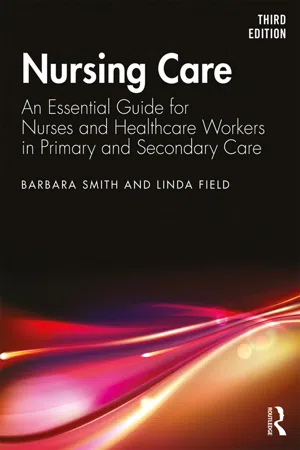Psychology
Rehabilitation
Rehabilitation in psychology refers to the process of restoring an individual's physical, mental, and social functioning after experiencing illness, injury, or addiction. It involves a combination of therapeutic interventions, support systems, and skill-building activities aimed at helping individuals regain independence and improve their quality of life. The ultimate goal of rehabilitation is to facilitate the individual's successful reintegration into society.
Written by Perlego with AI-assistance
Related key terms
Related key terms
1 of 4
Related key terms
1 of 3
11 Key excerpts on "Rehabilitation"
- eBook - ePub
- Shane J. Lopez(Author)
- 2011(Publication Date)
- Wiley-Blackwell(Publisher)
R Rehabilitation PsychologyTimothy R. Elliotta and Gitendra Uswatteba Texas A&M University;b University of Alabama at BirminghamRehabilitation psychology is committed to the development and application of psychological knowledge and services to promote the health and well-being of individuals who live with disabling conditions. The specialty has been historically linked with institutions that serve individuals who have disabling conditions (including hospitals, schools, universities, nonprofit organizations, and federal and state agencies). Rehabilitation psychologists, therefore, have actively participated in multidisciplinary service and research endeavors, program development and evaluation, administration, policy formation, advocacy, and training. Rehabilitation psychology was originally construed to serve those who encounter “deprivation and disability” that devalued their role in society in any fashion (including institutionalization, racism, poverty, older age, and chronic disease; Dembo, Diller, Gordon, Leviton, & Sherr, 1973, p. 719). However, the specialty is typically associated with the provision of psychological expertise on behalf of persons with congenital or acquired physical, neuromuscular, and developmental disabilities.Historical Context and DevelopmentMany psychologists, educators, and counselors responded to federal legislation to assist workers injured in the early twentieth century during the industrialization of the American working environment. The general thrust of this legislation and accompanying programs was directed toward compensating injured workers who could not return to their jobs, and to study work-related accidents to determine preventative measures. These efforts were complimented and expanded by legislation to assist soldiers injured in World War I and World War II. Legislation following World War II, in particular, was highly influential in addressing the psychological issues of personnel who incurred permanent disabilities. - eBook - ePub
- Robert King, Chris Lloyd, Tom Meehan(Authors)
- 2013(Publication Date)
- Wiley-Blackwell(Publisher)
Psychosocial Rehabilitation, also referred to as ‘psychiatric Rehabilitation’ (Anthony, 1998) or ‘Rehabilitation in mental health’ (NSW Health Department, 2002) has been a politically and scientifically suspect endeavour for some years. This has been particularly due to multiple definitions and poorly operationalised concepts (Anthony et al., 1982; Cnaan et al., 1988). It is difficult to claim that psychosocial Rehabilitation is effective, if researchers and practitioners apply the term differently. Anthony (1998) referred to the ‘black box’ of psychiatric Rehabilitation, stating that from a process point of view we know what the inputs are and what the outputs are, but what happens in between has been ill defined. This chapter provides a definition of psychosocial Rehabilitation consistent to that provided in Chapter 1, but goes one step further by prescribing five domains of psychosocial Rehabilitation. The definition is as follows:Psychosocial Rehabilitation is a purposeful interpersonal process that involves a person with a mental illness making subjective and objective progress towards at least one of the following aims: • Self-management of the mental illness and overall health • Meaningful occupation • Increased and improved social interaction and community inclusion • Management of a changed sense-of-self and emotions from living with a long-term mental illness, and • Improved living conditionsPsychosocial Rehabilitation involves professional or peer support services that provide interventions consistent with these five aims. There are many strategies for providing psychosocial Rehabilitation services to meet these aims and it is equally important for services to be able to describe comprehensively the range of specific service characteristics that meet these needs (e.g. philosophy, staffing, organisational structures, types of interventions provided, etc.).The definition of psychosocial Rehabilitation above complements recovery, as described in Chapter 1, which can be viewed as a personal rather than interpersonal process. Recovery may or may not involve these five areas, but is likely to involve the management of a changed sense-of-self and emotions related to living with a long-term mental illness. The metaphor of a lens is useful to clarify and understand the topography of psychosocial Rehabilitation. A lens can zoom in to characteristics of an individual’s chemistry or zoom out to communities and society. A lens can be well focused or out of focus. A lens can take stills, snapshots such as measurement of outcomes, or ongoing films, such as understanding the recovery process. Different lenses will emphasise different aspects of the topography, for example emphasising the empirical, the ethical, the economic or the conceptual. A lens can have different filters, for example highlighting deficits or strengths. A lens can capture a myriad of brilliant colours (e.g. quality of relationships) or just black and white (e.g. hospitalised or not). Moreover, a lens can be held by different people (e.g. family, consumer, clinician) from many different vantage points (e.g. control, care) and is portable. - eBook - ePub
- (Author)
- 2020(Publication Date)
- Wiley-Blackwell(Publisher)
Although some assessment instruments and interventions are similar to clinical health psychology, readers will understand how Rehabilitation psychology contrasts with health psychology in its roles and focus. The role of Rehabilitation psychology in research, advocacy, and training is also explained. For further information on Rehabilitation psychologists performing as program developers, policy makers, and healthcare administrators, readers are encouraged to review Cheak‐Zamora, Reid‐Arndt, Hagglund, and Frank (2012). Practice of Rehabilitation Psychology: Assessment In Rehabilitation psychology, the assessment process is used to develop a multidisciplinary or interdisciplinary treatment plan that addresses the impact of a disability or other chronic health condition. In addition, adjustment and accommodation to the disability along with the necessary social and community supports to optimize functioning are also evaluated. Reasons for referral are many: individuals may be referred for assessment of physical, cognitive, emotional, and/or social adaptation to injury, illness, and disability in the patient and family; cognitive, emotional, and behavioral dysfunction; neuropsychological evaluation to determine ability to function at home, school, and/or work with or without accommodations; evaluation of self‐care and independent living skills; evaluation of psychosexual functioning, with an emphasis on education regarding disability‐related changes and use of adaptive technology; evaluation of social and recreational participation; assessment of health self‐management and prevention of secondary complications; and assessment of caregiver status and functioning, including caregiver knowledge and skills, social support, and self‐care - eBook - ePub
Recovery From Disability
Manual of Psychiatric Rehabilitation
- Robert P. Liberman(Author)
- 2009(Publication Date)
- American Psychiatric Association Publishing(Publisher)
» Our part of the bargain is to mobilize as many of the evidence-based treatments as are available and relevant for helping our patients achieve their personal goals en route to recovery. Giving value and credence to recovery as an uncompromising goal and vision for Rehabilitation can also motivate practitioners, patients, family members, managers, policy makers, and other stakeholders to reform our current systems of care by bringing evidence-based services into everyday practice.•Impairments, disabilities, and handicaps can be reduced or overcome by integrating pharmacological and psychosocial services with advocacy for improved clinical, educational, vocational, and governmental policies and practices.» Governmental policies such as those covering disability benefits, the Americans with Disabilities Act, and nondiscriminatory employment and housing make it possible for mentally disabled persons to have funds for subsistence, employment with reasonable accommodations, and residences in normal community neighborhoods.• Individualization of treatment is a fundamental pillar of Rehabilitation.» Rehabilitation rests on respect for the uniqueness of each individual, including an understanding of how family, cultural, and ethnic diversity inform diagnosis, functional assessment, and treatment response.• Rehabilitation is more effective and recovery more rapid when patients and families are actively involved in planning and participating in treatment.» Formation, maintenance, and continuity of a collaborative, positive partnership among practitioner, patient, and family are achieved through interpersonal competencies of the practitioner.• Integration and coordination of services are essential to enhance progress toward recovery.» Multidisciplinary collaboration and communication are necessary among practitioners and agencies responsible for optimal blending, coordination, and consistency of pharmacological and psychosocial services.• Building on patients’ strengths, interests, and capabilities is a cornerstone of Rehabilitation.» Practitioners utilize educational and behavioral techniques to enhance learning of skills. Empowerment, responsibility, and self-esteem are acquired through success in obtaining skills, using one’s abilities, and attaining one’s personal goals. - eBook - ePub
Positive Psychology in Practice
Promoting Human Flourishing in Work, Health, Education, and Everyday Life
- Stephen Joseph(Author)
- 2015(Publication Date)
- Wiley(Publisher)
For example, in 1972, Wright formulated 20 “value-laden” guiding principles that underlie Rehabilitation psychology (Wright, 1972, 1983). These principles continue to have a strong influence on the field. She stressed the dignity and rights of persons with disabilities, the relevance of psychological factors throughout the Rehabilitation process, the importance of considering the embeddedness of the persons with disabilities in immediate and larger social and physical environments, and the importance of involving and empowering the affected persons themselves in shaping Rehabilitation, community, and policy processes. She stated that “it is essential that society as a whole continuously and persistently strives to provide the basic means toward the fulfillment of the lives of all its inhabitants, including those with disabilities” (Wright, 1983, p. xv). Wright further emphasized that “the assets of the person must receive considerable attention in the Rehabilitation effort” (Wright, 1983, p. xii).Rehabilitation psychology does not solely focus on deficits, but considers the whole-life situation of the person from physical, psychological, and social perspectives, adhering to the dictum of Lewin that behavior is influenced by both personal and environmental factors, B = f(P,E) (Larson & Sachs, 2000; Lewin, 1936). It considers the physical and social environment of individuals with disabilities ranging from assistive devices, architectonical barriers, family caregivers, societal attitudes, or the availability and affordability of support services. Rehabilitation psychology examines what still works and strives for constructive and creative solutions in the interaction of person, body, psyche, and physical and social environment (Dunn & Dougherty, 2005). Positive psychology, in contrast, pays less attention to environmental factors, with the exception of social resources (Ehde, 2010). Research indicates that a full 10% of the variation in well-being is dependent on environmental circumstances (Lyubomirsky, 2007). Given these findings, it seems important to take person–environment interactions into account when developing models of well-being (see also Layous, Sheldon & Lyubomirsky, Chapter 11 , this volume).Focus on Individual Strengths and Resources
Both Rehabilitation psychology and positive psychology view personal strengths and psychological resources as foundational elements that contribute to well-being and flourishing. Dunn and Dougherty (2005) state: “The presence of disability does not negate an individual's existing assets, nor does it preclude the acquisition of new ones” (p. 306). In Rehabilitation psychology, disability is seen as “only one aspect—and not a defining characteristic—of an individual's identity” (Dunn & Dougherty, 2005, p. 306). People with disabilities, like all individuals, possess a range of strengths, resources, assets, and abilities that exist despite disability and chronic disease. In individuals with disabilities, the optimal use of strengths and a resource-based approach is essential, because they will not necessarily “heal,” but will need to manage and thrive despite persistent impairments and limitations. - eBook - ePub
Psychological Management of Physical Disabilities
A Practitioner's Guide
- Paul Kennedy(Author)
- 2007(Publication Date)
- Routledge(Publisher)
et al., 2000). Rehabilitation psychologists provide a broad range of services across diverse settings to a variety of health consumers. They have worked shoulder to shoulder with colleagues in medicine, nursing and education to address the varied health and social concerns of people with disabilities (Frank and Elliott, 2000). This book highlights how Rehabilitation psychologists contribute to primary care, areas of specialist medicine and in broader research and health education capacities to increase function, minimise disability, and increase opportunities for engagement and greater social participation of people with disabilities and their families.Table 1.1 Major conditions causing physical disabilityIt is estimated that there are 33 million persons with disabilities in the United States (US Census Bureau, 1997), many of whom require assistance in relation to bathing, dressing and toileting. According to the Health Survey for England (Joint Health Surveys Unit, 2002), 18 per cent of men and women aged 16 and over reported having one or more of five types of disability (locomotor, personal care, sight, hearing and communication) and 5 per cent of adults were found to have a serious disability. There are wide variations in the types and causes of disability and each of these has a different impact on the lifecycle. For example, spina bifida is a congenital condition which affects individuals throughout their lifespan, whereas the age of onset of asthma tends to be by the age of 8 or 12, and with other conditions such as rheumatoid arthritis, diabetes and coronary heart disease, increase in age is positively associated with greater physical disability. Disability may also result from accidents such as with spinal cord injury and traumatic amputations, or degenerative neurological diseases and cerebral vascular accidents. In the UK, the prevalence of severe disability remains stable until the age of 60, and from then on in, there is an increase in the prevalence, severity and range. In general, there are four broad conditions that account for most of the physical disabilities in the UK. These are illustrated in Table 1.1 - eBook - ePub
- Federica Coppola, Adriano Martufi, Federica Coppola, Adriano Martufi(Authors)
- 2023(Publication Date)
- Routledge(Publisher)
Lewis 2005 ), for some, this will mean the restoration of a former state. For others, this will mean the acquisition of knowledge and skills, as well as the establishment of rank, rights, and responsibilities previously denied. For others, this will entail a process of reversion and overcoming of traumas and victimisations. For others, this will imply a process of accountability through an appreciation of the interpersonal and normative values that they violated that may serve as a guidance for future behaviours. Altogether, while the aim of social Rehabilitation (that is, social reintegration or restoration) is unitary, the possible means to achieve it are various and multifaceted in view of individual and structural factors inherent to the relevant person.The main features of social Rehabilitation, including the dynamic view of the ‘person’ and the importance of social bonds as triggers for positive change, find robust support in a large body of studies from social and behavioural sciences. These disciplines have been offering increasingly detailed evidence about the importance of meaningful social bonds and positive social environments for the psychological well-being and effective reintegration of individuals. Importantly, this sustained line of research aligns with studies in positive criminology about the individual and social factors involved in crime desistance, which have taken an enormous leap over the years (for example, Maruna 2016 ; Weaver 2016 ; Rocque 2017 ; Bersani et al. 2018 ).Recent views in the literature (for example, Coppola 2018 , 2021 ; Ligthart et al. 2019 ) have also drawn links between such fundamental aspects of social Rehabilitation and growing insights about the ineradicable relationship between the social environment, the human brain, and behaviour change emanating from social neuroscience. Growing neuroscientific evidence emphasises the innate plasticity of the human brain; that is, it suggests that the human brain is subject to continuous change amid new environmental stimuli, including behavioural interactions and experiences. Consistent with behavioural studies, insights into neuroplasticity overall suggest that individuals are in continuous evolution and capable of continuous growth, with an innate receptiveness to change and adaptation that potentially endures throughout life. Critically, studies on neuroplasticity have evidenced that healthy environments and social connections, including meaningful social relationships, stable social bonds, social inclusion, and perceived belongingness, foster positive changes in the brain regions that support the cognitive and emotional functions and processes that are involved in morality and prosocial behaviour. Meanwhile, social exclusion, as well as negative environments and experiences, can profoundly alter the brain pathways that are involved in the cognitive and emotional functions that support positive social behaviour. Importantly, this body of empirical evidence appears to call into serious question certain (still popular) criminal justice practices, such as solitary confinement, (Coppola 2019 , 2020 - eBook - ePub
- George Prigatano, Neil Pliskin(Authors)
- 2020(Publication Date)
- Psychology Press(Publisher)
At its basic level, cognitive Rehabilitation can be regarded as remediation or reduction of cognitive deficits following insult to the brain. However, a number of alternative definitions can be found in papers published since the term gained popular usage in the 1980s. Many of the existing definitions are imprecise or limiting, such as those proffered by Gianutsos (1980s, p. 37): “a service designed to remediate disorders of perception, memory and language,” and by Wood (1990, p. 3): “Cognitive Rehabilitation uses an assortment of procedures to improve or restore a diverse collection of abilities and skills.” Closer to our own view is a definition by Sohlberg and Mateer (1989), who suggested,Cognitive Rehabilitation . . . refers to the therapeutic process of increasing or improving an individual’s capacity to process and use incoming information so as to allow increased functioning in everyday life. This includes both methods to restore cognitive function and compensatory techniques, (pp. 3-4)Sohlberg and Mateer continued by stating, “Cognitive Rehabilitation applies to therapy methods that actually retrain or alleviate problems caused by deficits in attention, visual processing, language, memory, reasoning/problem solving, and executive functions” (p. 4).Ben-Yishay and Prigatano (1990) offered a variation on this when they suggested that cognitive Rehabilitation is “the amelioration of deficits in problem solving abilities in order to improve functional competence in everyday situations (p. 395).One factor missing from such definitions is a recognition that any kind of Rehabilitation is an interactive process involving the disabled person, therapeutic staff, and probably also relatives and the wider community (McLellan, 1991). Recognizing the fundamental importance of this interactive process, in this chapter we have taken as our basic premise that cognitive Rehabilitation is “a process whereby brain injured people work together with health professionals to remediate or alleviate cognitive deficits arising from a neurological insult” (Wilson, 1996, p. 637). Our arguments in this chapter will be supported by an extension of this premise to include any strategy or technique that enables brain-injured people and their families to understand, come to terms with, bypass, or reduce cognitive deficits in order to function as adequately as possible in an environment that is most appropriate to them. - eBook - ePub
Clinical Neuropsychology
A Practical Guide to Assessment and Management for Clinicians
- Laura H. Goldstein, Jane E. McNeil(Authors)
- 2012(Publication Date)
- Wiley(Publisher)
Part 6 RehabilitationPassage contains an image 19 Theoretical Approaches to Cognitive Rehabilitation Fergus Gracey and Barbara A. Wilson Introduction
The Royal College of Physicians and British Society for Rehabilitation Medicine (BSRM) in the United Kingdom define Rehabilitation as ‘a process of active change by which a person who has become disabled acquires the knowledge and skills needed for optimal physical, psychological and social function,’ and in terms of service provision this entails ‘the use of all means to minimise the impact of disabling conditions and to assist disabled people to achieve their desired level of autonomy and participation in society’ (Royal College of Physicians and British Society of Rehabilitation Medicine, 2003, p. 7). In the terms of the United Kingdom's Medical Research Council's (2008) guidelines on healthcare research, Rehabilitation in general, including cognitive Rehabilitation, can be considered a ‘complex healthcare intervention’ in that it involves varied clinical presentations and problems, described at different levels of explanation, with deficits likely to interact, requiring multiple targets of change, multiple behaviours and skills on the part of the clinicians, delivered across multiple treatment and community contexts.Rehabilitation is, therefore, one of many fields that needs a broad theoretical base incorporating frameworks, models and methodologies from a number of different fields. This chapter considers some of the influential models relevant to cognitive Rehabilitation together with their strengths and weaknesses, and their impact on current clinical practice. A key aim of this chapter is to illustrate how models of cognitive functioning alone will not help to inform us about the multiple factors that may influence engagement, change and maintenance of Rehabilitation gains.What Is a TheoreticalModel?A theoretical model is a representation that helps to explain and increase our understanding of related phenomena. Models vary in complexity and detail, ranging from simple analogies, to help us explain relatively complex situations such as the ‘faulty switch’ analogy to help explain why someone is sometimes able and sometimes unable to carry out a task, through to highly complex computer-based representations to predict the weather. In Rehabilitation, models are useful for facilitating thinking about treatment, explaining treatment to therapists and relatives, and enabling us to conceptualize interventions and outcomes. This is especially important when working with complex healthcare interventions. The Medical Research Council (2008) guidelines note the importance of theoretical accounts of the disorder being treated, the intervention itself and the change process in evaluating complex interventions. They argue that by measuring the hypothesized effects of treatment components in addition to pre–post outcome measures, one can advance scientific understanding of the intervention as well as the disorder being targeted. Attempts to conceptualise the Rehabilitation process have been made (e.g., Gracey, Evans and Malley, 2009; Hart, 2009). Hart contrasts complex Rehabilitation interventions (where the specific influence of the content and process of the intervention are often not known) with pharmacological interventions where such factors may well be known. These authors’ proposals signify a convergence between Rehabilitation research and psychotherapy research – understanding the biological or neuropsychological processes is helpful and may point towards potential treatments. However, other factors such as therapist skills and features of the therapeutic interaction (process and content) are also critically important. - eBook - ePub
Nursing Care
An Essential Guide for Nurses and Healthcare Workers in Primary and Secondary Care
- Barbara Smith, Linda Field(Authors)
- 2019(Publication Date)
- Routledge(Publisher)
Rehabilitation can be a lifetime activity: very few cases of Rehabilitation are time-limited. Rehabilitation service provision varies from region to region and at different times within a person’s lifetime. The provision of holistic Rehabilitation can be financially costly; but not providing emotional Rehabilitation can be devastating for the patient.The Rehabilitation team
We now consider the different people who make up the Rehabilitation team. Successful Rehabilitation is about teamwork and often involves a large number of different professionals (Figure 9.2 ).Figure 9.2 Rehabilitation teamRehabilitation teams work in a variety of settings, including general and specialist hospitals and the community. Although the members of the team come from different disciplines, their primary aim must be to work together and with the patient to treat and rehabilitate. Agreement of goals and outcomes is integral to successful teamworking. Most patient-centred goals will require the involvement of more than one discipline at any one time. It is important that all team members work together to achieve patient-centred goals rather than trying to achieve only those goals that are specific to the discipline in which they work. For example, in Case studies 9.1a and 9.1b, Mrs Main needed help to be able to dress independently. A number of disciplines were involved in helping her to achieve this goal:- A physiotherapist ensured Mrs Main could sit up and was able to balance while dressing.
- An occupational therapist taught Mrs Main to use certain equipment and adaptations to assist.
- Ward nurses and Rehabilitation support workers assisted with Mrs Main’s personal hygiene, washing and dressing and continued the programmes set by the physiotherapist and occupational therapist.
Rehabilitation teams work in various ways
- Multidisciplinary teamworking:
- eBook - ePub
Principles and Practice of Restorative Neurology
Butterworths International Medical Reviews
- Robert R Young, Paul J Delwaide(Authors)
- 2013(Publication Date)
- Butterworth-Heinemann(Publisher)
As soon as possible after injury, often within the first few days, physical Rehabilitation is commenced. The term is used here to include the various therapeutic approaches undertaken by members of the interdisciplinary Rehabilitation team, such as physical therapy, occupational therapy, speech therapy, and recreational therapy. Rehabilitation nurses, psychologists, vocational rehabilitators, and others are included in the team in addition to the clinician trained in Rehabilitation who is the team leader.Multi-therapy Rehabilitation begins as soon as possible and is as intense as possible. In fact, if there are not sufficient hours per day of therapy, reimbursement for the Rehabilitation services may be withheld. Therapy usually involves having the patient taken to each therapist on a regular daily schedule. This program is sustained during the hospitalization period and is often continued when the patient is discharged.It should be pointed out that there is little or no demonstrated scientific basis for most of the procedures, and few of the procedures have been validated by controlled studies. The importance of the intervention of the various therapies (e.g. speech, occupational, physical, and recreational therapy) has not been demonstrated. The requirements of neuroRehabilitation are great, and the heavy demand for services has led to a considerable growth of neuroRehabilitation facilities and professional groups. Each group is firmly convinced of the need for, and value of, its services; both profit making and non-profit making facilities, units, and multi-site corporations have proliferated. Patients do improve and the services are reimbursed, and as a result new service units continue to appear. Yet there is a dearth of evaluation data. Not only is the relative contribution of each program and separately named therapy not firmly established, but the required level of participation by each of the medical specialties involved in Rehabilitation has not been determined.The early application of intensive Rehabilitation may lead to the greatest level of recovery (e.g. monkey study by Black, Markowitz, and Cianci, 1975
Index pages curate the most relevant extracts from our library of academic textbooks. They’ve been created using an in-house natural language model (NLM), each adding context and meaning to key research topics.
Explore more topic indexes
Explore more topic indexes
1 of 6
Explore more topic indexes
1 of 4

